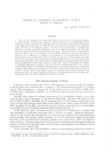Chemical Control of Soybean Insect Pests in Brazil
Tropical agriculture research series : proceedings of a symposium on tropical agriculture researches
| ISSN | 03889386 |
|---|---|
| NII recode ID (NCID) | AA00870529 |

Full text
tars16-_77-86.pdf1.82 MB
Much of the increasing use of insecticides in Brazil has been due to the booming expansion in soybean acreage. Currently three regions of soybean production can be distinguished: (i) the traditional southern region; (ii) the expanding region of Central Brazil, and (iii) the potential area of flat lands of Northern Brazil. In 1982, 80.4% of all soybeans were produced in the traditional region and 19.5% in the expanding region. The major pests causing damage to soybeans are:
velvetbean caterpillar (Anticarsia gemmatalis); stem borer (Epinotia aporema); and stink bugs (Nezara viridula, Piezodorus guildinii, and Euschistus heros). These three pests are responsible for
more than 90% of the total insecticides used on soybeans. Brazil's 8.2 million hectares, with a production of 13 million tons of soybean, are responsible for a considerable share of the 72.3 thousand tons of insecticides sold in 1981. In general, soybean growers used to apply insecticides four or five times each season, representing a significant addition to the cost of production and environmental pollution. As a result, research on integrated pest management (IPM) and biological control methods have received high priorities in recent years. Based on IPM studies, the number of insecticide applications necessary for the pest control was reduced from five to two, with an overall saving of 58.4%. For the State of Parana alone, over a period of three years, it represented a saving of 93.8 million liters of diesel fuel, 13.35 million liters of insecticides and an economy of US$132.5 million. With several million hectares of untouched land presently included in the government's plan for future soybean production in the expanding and potential regions, the future demand for insecticides in Brazil will certainly be increased.
velvetbean caterpillar (Anticarsia gemmatalis); stem borer (Epinotia aporema); and stink bugs (Nezara viridula, Piezodorus guildinii, and Euschistus heros). These three pests are responsible for
more than 90% of the total insecticides used on soybeans. Brazil's 8.2 million hectares, with a production of 13 million tons of soybean, are responsible for a considerable share of the 72.3 thousand tons of insecticides sold in 1981. In general, soybean growers used to apply insecticides four or five times each season, representing a significant addition to the cost of production and environmental pollution. As a result, research on integrated pest management (IPM) and biological control methods have received high priorities in recent years. Based on IPM studies, the number of insecticide applications necessary for the pest control was reduced from five to two, with an overall saving of 58.4%. For the State of Parana alone, over a period of three years, it represented a saving of 93.8 million liters of diesel fuel, 13.35 million liters of insecticides and an economy of US$132.5 million. With several million hectares of untouched land presently included in the government's plan for future soybean production in the expanding and potential regions, the future demand for insecticides in Brazil will certainly be increased.
| Date of issued | |
|---|---|
| Creator | José Tadashi YORINORI |
| Publisher | Japan International Research Center for Agricultural Sciences |
| Volume | 16 |
| spage | 77 |
| epage | 86 |
| Language | eng |
